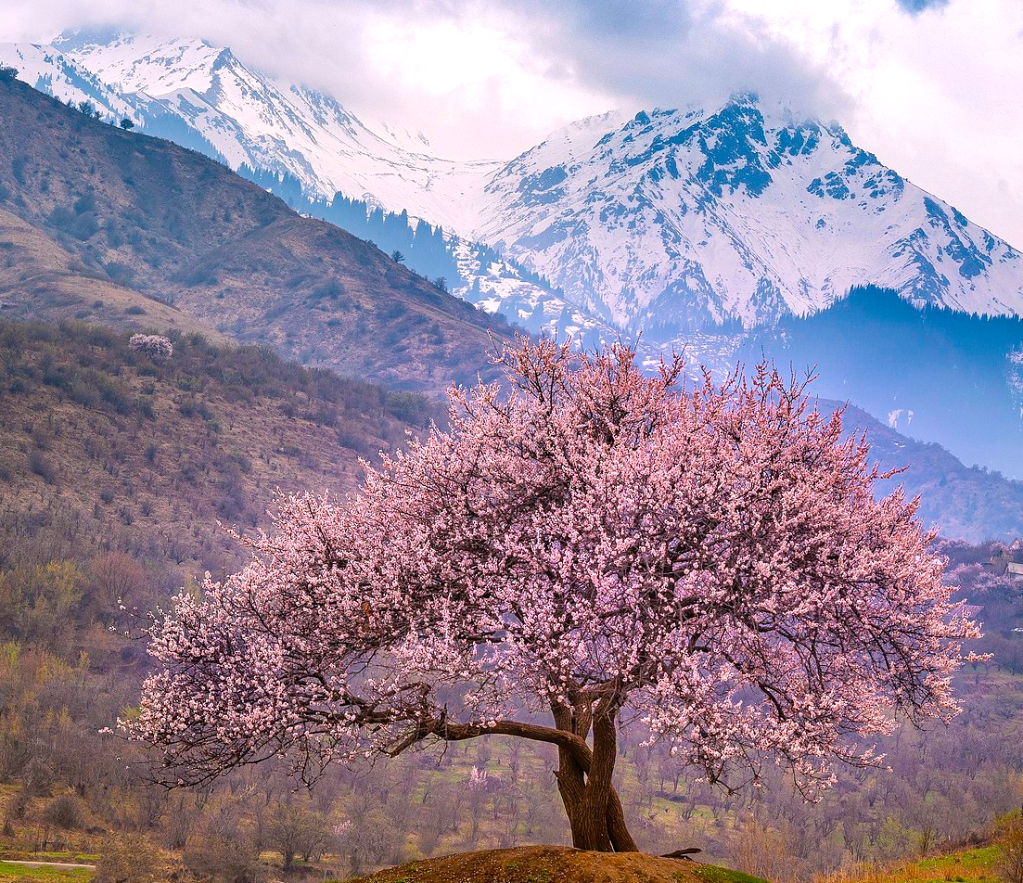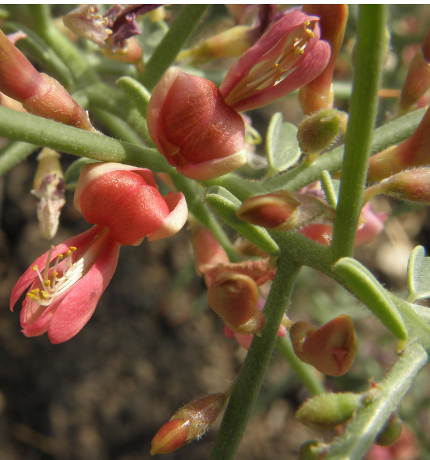After Mother N. passed away, I dreamed about her in a new life restoring an ancient church in the mountains. There was a sequel dream the very next night.
In the sequel dream, the whole congregation was moving away to Mother’s new church. The women brought colorful flowering plants from their gardens, potted in shiny cans of rich soil for the trip. The men took the cans and loaded them on an open-bed truck. For this final load everyone worked fast, so the flowers would arrive still fresh and healthy. Mother would be happy to see them and to have a garden again.
I stood there feeling sad to watch everyone go. The truck looked like a lovely float in some feast day processional. But how would this lush blooming rainbow take to the high windswept altitude, the steep terrain of large stones under the sun?
“Hurry!” a dreamtime intuition told me. “Speak up! Tell them the names of the right flowers and trees to bring. Things that can bloom where they are planted.”
But how? I didn’t know landscaping. I’ve never experienced a climate like that.
“It’s in Cancer Ward!” the intuition nudged me. “The ‘j’ word. Tell them!”
Oh! Plants from Cancer Ward might just work. Sol’zhenitsyn’s novel takes place in Kazakhstan. The book’s hero, Kostoglotov, is a cancer patient released from the Gulag and exiled to Kazakhstan “in perpetuity,” meaning that even after his imminent death not even his body can be brought back to Russia. In the days he has left after his hospital treatment, he resolves to appreciate whatever good thing he can find in exile, including its people and its plants.
Does Cancer Ward have a plant starting with “j”? For the rest of the dream, in fitful sleep, my brain went spinning through its memory banks of the text of the novel for any possible “j” words. My memory did recall the almond tree right at the end, flowering like a glorious pink cloud. But the “j” word?
Finally my dream intuition lost patience with me. “Then tell them to plant Camelthorns!” it said.
Camelthorn? That’s not a “j” word, and it doesn’t appear in Cancer Ward. Is that even a plant name? It can’t be. There’s no such word anywhere. The term sounded like some earthy irreverent joke. I certainly couldn’t say it to a flock of devoted Orthodox Christians setting out on a mission!
The congregation finished loading the truck. I stood waving my arms and tried to call out after them, but in the dream I was invisible. They couldn’t see me or hear my voice, because I didn’t know the “j” word to catch their attention. As I stood there trying to speak, they drove away for good. That was the end of the dream.
I woke up anxious and tired, an hour before the alarm set for a day at the office. To fading stars and a single robin stirring from sleep to song, I lay there thinking through the dream. “Camelthorn”? What a strange figment of imagination!
I hopped out of my blanket roll and went to the bookshelf for the English translation of Cancer Ward. First I opened the book toward the end, and found that my dream memory was wrong: the wondrous pink cloud tree is not an almond, but a Central Asian flowering apricot, or uriuk. In the book it’s a touching scene. Kostoglotov somehow survives his long siege of hospitalization. At dawn he sets foot on the streets of the free world outside, and is astonished by the tree’s beauty, a globe of pure rose in the early rays of sun.
Here is an uriuk tree at the Ile-Alatauskii National Park, Almatinskii region. https://ru.wikipedia.org/wiki
Иле-Алатауский национальный парк: Алматинская область
So there was one solution. Mother would be delighted to have her own apricots, and a lavish tree blooming right around Paskha.
But the “j” word? The table of contents showed a Chapter 20, “Memories of Beauty.” Here Kostoglotov, still in the city hospital, is reminiscing about the wild plants in his village of exile. And look: the passage has not one “j” word, but four of them!
[He remembered] …the jusan of the steppe…. the jantak with its prickly thorns, and the jingil, even pricklier, that ran along the hedges, with violet flowers in May that were as sweet-smelling as the lilac, and the stupefying scented blossoms of the jidu tree….
Here are the plants, one by one.
1. Jusan. In English that’s “bitter ” or “grand” wormwood, or Artemisia absinthium. The plant is one ingredient used in absinthe. Absinthe has a reputation as a strong high-alcohol spirit; in some countries it has been banned at various times as a hazardous beverage. Our local county extension service in our mild rain-rich climate calls it an invasive species. But on the steppes, in its right place with other plant life, it’s just a naturallly occurring hardy survivor.
A different kind of Artemisia appears in Revelation 8:10-11:
[T]here fell a great star from heaven, burning as it were a lamp, and it fell upon the third part of the rivers, and upon the fountains of waters;and the name of the star is called Wormwood: and the third part of the waters became wormwood; and many men died of the waters, because they were made bitter.
Wormwood is Чорнобиль in Ukrainian, Чернобыль in Russian, transcribed in English as Chernobyl.’ In the 1980s, over and over I heard devout Christians from Ukraine and Russia quote these Revelation verses. It was heartbreaking to hear them confide their fear that God sent nuclear disaster as punishment to their people for their sins. Perhaps that was one way for them to face tragedy and reach for meaning and connection.
2. Jingil
This search term defaults to “Jingil Bells” as a jolly holiday tune. So I switched alphabets and searched in Cyrillic, trying жингил, or zhingil. Aha! Russian Wikipedia came through. Its additional language options include Kazaksha, or Kazakh, which luckily uses Cyrillic spelling for a helpful cross reference showing original plant names — in this case жынгыл or zhyngyl, a spelling combination not admitted in Russian orthography but fine in Kazakh.
Zhyngyl is a Tamarisk, a tree with dozens of varieties. One is in Genesis 21:33.
Abraham planted a tamarisk in Beersheba, and called there on the name of the Lord, the everlasting God.
The tamarisk has an affectionate mention in Willa Cather’s Death Comes for the Archbishop. Missionary Father Joseph on his long treks through the deserts of New Mexico welcomes the sight of every tamarisk as a sign that nearby there will be water, and a welcoming Mexican household:
[T]he tamarisk waved its feathery plumes of bluish green…. and its fibrous trunk is full of gold and lavender tints.
The whole passage sounds romantic in the novel. But don’t plant it in your yard or anywhere else. The tree can suck up and evaporate 200 gallons of precious ground water every day, to grow into a highly flammable flame starter. But again, in its native arid desert it might stay manageable and appealing, as in this Getty Image:
3. Jidu
This search went nowhere. After typing in various tricks and turns, I wondered: could that final “u” possibly represent the feminine accusative of a hypothetical nominative feminine final “a”? I wasn’t out to correct Sol’zhenitsyn’s Russian, but wouldn’t mind questioning the English translation. I went back to the bookshelf for the Russian text. Eureka! The hero’s reminiscences go on for several independent sentence phrases. But all are governed by the initial verb “to remember.” So yes, in Russian that would place all the “j” word plants in subsequent sentences right into the accusative case. The root noun is Jida. Cyrillic doesn’t have a letter “j,” so one would need to search for either zhida or else dzhida.
Zhida worked, turning up the Elaeagnus tree:
They’re cultivated for their silvery foliage, the edible fruit (at least in some varieties), and their resistance to wide temperature extremes and drought.
4. Jantak
A search for zhantak turned up Alhagi maurorum. In our county extension registry that’s an invasive weed. But in its native desert, the tree’s sweet sap sustained pilgrims traveling for Al-Hajj to Mecca, hence the name Alhagi. https://en.wikipedia.org/wiki/Alhagi_maurorum
Honey derived from the tree makes Alhagi “a promising medicinal plant” according to this PubMed article: https://www.ncbi.nlm.nih.gov/pmc/articles/PMC4739472/
That concluded the search for proper trees to fit with Mother N.’s church in my dreams. All four “j” words from Cancer Ward are searchable in Library of Congress transcription as zhusan, zhingil, zhida, and zhantak. All describe plants which properly belong in arid sunscapes. All four have potential usefulness, and even their own kind of beauty. Mother was an accomplished practical gardener and herbalist, and would have welcomed them all. For someone still grieving her death, it was a comfort to work through this dream and learn new appreciation for the plants of Kazakhstan — the world’s largest landlocked country, origin of the apple and the tulip!
Oh, this last tree, the Alhagi maurorum: According to our county extension guide, the English name is Camelthorn.






This is amazing, Mare! The dream is so rich & layered & I LOVED the botany lesson! Love, yer sis
Very dear favorite Sis, it is so nice to see you and your kind words here! Mother N. was someone worth dreaming about, a very strong woman who spent her life serving people and the church, and she so loved flowers and growing things… I guess the dream was a way to create some meaning and some peace out of it all. Thank you so much! I love you, sis M
I love you too! 🌹🌸💐🌺🌷🌻🥀💗
Nice flower emojis! Can we design emojis for zhusan zhantak zhida zhyngyl? Love!